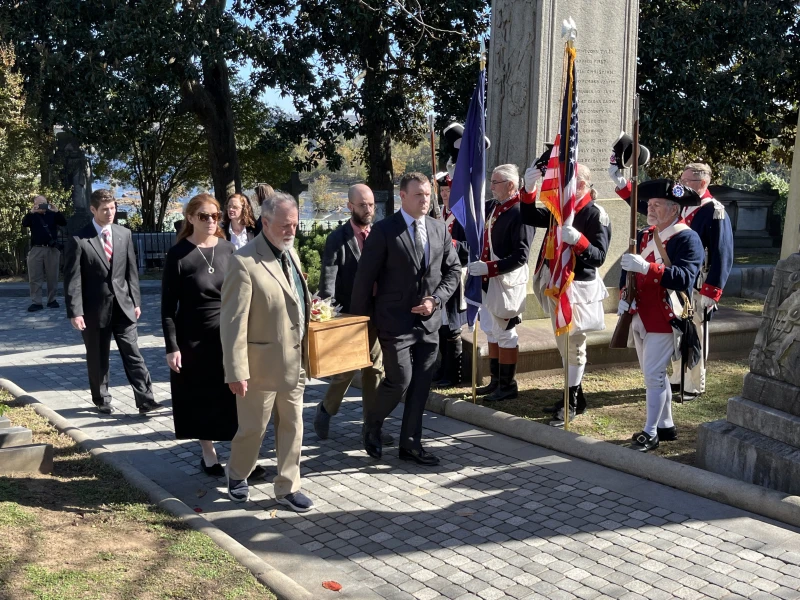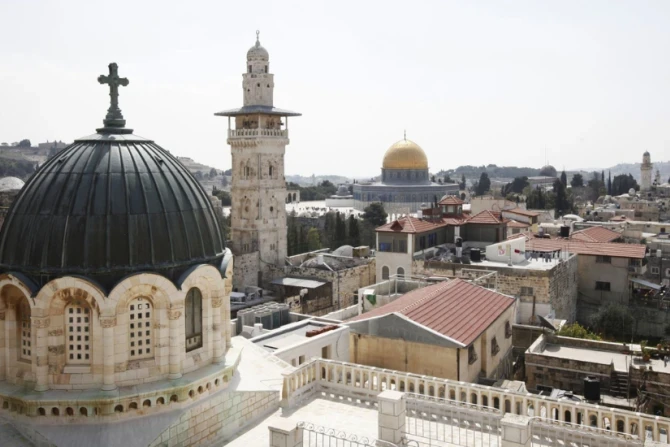

A color guard stands at attention as Eliza Monroe Hay’s remains are carried for reinterment at Hollywood Cemetery in Richmond, Virginia, on Thursday, Oct. 23, 2025. / Credit: Daniel Payne/CNA
Richmond, Virginia, Oct 23, 2025 / 17:04 pm (CNA).
Nearly two centuries after her death, the daughter of American Founding Father James Monroe has been laid to rest in Richmond, Virginia, joining her family’s historic burial plot in the city’s famed Hollywood Cemetery.
The Diocese of Richmond held Eliza Monroe Hay’s reinterment at the top of Hollywood Cemetery overlooking the James River on Oct. 23. Hay, who died in 1840, converted to Catholicism several years before her death.

State Sen. Bryce Reeves, who worked with the Eliza Project to repatriate Hay’s remains, said she was “far more than the daughter of a president.”
He described Hay as strong-willed and intelligent. “She served this nation quietly but powerfully in its formative years,” he said.
The historic reinterment came about from a yearslong effort by the Eliza Project to bring Hay’s mortal remains home from the Cimetière du Père-Lachaise, a cemetery on the outskirts of Paris.

Born in Fredericksburg, Virginia, in 1786, Hay grew up in both the U.S. and Paris, where her father was the American ambassador amid the ongoing French Revolution.
She would later be known for serving as an unofficial First Lady of the White House during James Monroe’s presidency, as her mother Elizabeth’s health regularly kept her away from state functions.
Hay’s husband, Virginia attorney George Hay, died in 1830, as did her mother. James Monroe died in 1831 and was by then one of a dwindling number of prominent U.S. citizens who had led the country through its founding and earliest years.
Hay herself subsequently returned to Paris, where she converted to Catholicism before she died.

A happy ending
Delivering Hay’s eulogy at the event, Virginia resident Barbara VornDick described Hay as “my friend from the past.”
VornDick said in an Oct. 21 press release that the effort “has been a fascinating, enriching journey in many ways,” though she said the “most amazing aspect was how it enriched my faith.”
She told the Arlington Catholic Herald in August that she spent years researching Hay’s life. She discovered that a popular family legend that Hay became a nun was untrue, but her conversion to Catholicism was confirmed by records at St.-Philippe-du-Roule Church in Paris, where her funeral Mass was held in 1840.
Hay also reportedly received a piece of jewelry from the Vatican — a cameo of the head of Christ — along with a note from Pope Gregory XVI’s secretary of state.
During her years at the White House, Hay gained a reputation as an unpleasant, demanding hostess. Reeves said at the Oct. 23 ceremony that Hay was at one time described by John Quincy Adams as an “obstinate little firebrand.”
The Eliza Project, however, says she had a record of “good deeds and generosity” that history has largely forgotten.
“She gained increasing admiration for her nursing of the sick: for family, for friends, and, during two epidemics, for the people of Washington,” the project said.
She also exhibited “a sense of duty and loyalty, strength of character and fortitude, and compassion for the sick and suffering.”

The Diocese of Richmond had earlier held a memorial Mass for Hay at the nearby Cathedral of the Sacred Heart before the interment at Hollywood Cemetery. Father Tony Marques, the rector of the cathedral, presided over the Rite of Committal on Oct. 23. The cathedral’s choir performed at the ceremony.
Describing the yearslong project to repatriate Hay’s remains as a “grassroots effort,” Reeves told the assembled crowd on Tuesday: “The Virginian thing to do was bring Eliza home.”
VornDick told the Herald that the yearslong effort to “bring Eliza home” was motivated by the likelihood that she “never intended to die” in Paris.
“I just wanted to make it right for her,” she said.
At the reinterment, meanwhile, VornDick described Hay as a “daughter, sister, wife, and grandmother,” one who stands out in history for her devotion, service, and forceful personality.
“Today marks the end of the Bring Eliza Home Project,” she said. “But it is a happy ending.”
Read More![Military archdiocese: Army’s response to canceled religious contracts ‘inadequate’ #Catholic
Archbishop Timothy Broglio speaks at Mass on Dec. 3, 2023. / Credit: The Basilica of the National Shrine of the Immaculate Conception
Washington, D.C. Newsroom, Oct 22, 2025 / 18:04 pm (CNA).
The Archdiocese for the Military Services, USA, expressed concern that the U.S. Army is not adequately addressing its discontent with canceled religious contracts, which the archdiocese said is straining its ability to minister to Catholics in the armed forces.This month, the Army canceled all contracts for three roles: coordinators of religious education (CRE), Catholic pastoral life coordinators (CPLC), and musicians. The contract terminations affected Catholics and those of other faiths.CREs served as catechists trained by the archdiocese to assist the priests in religious education in the military chapels. The archdiocese also trained CPLCs who offered administrative support such as liturgy coordination, assistance with sacramental record documentation, and weekly bulletin preparation. Contracts also included musicians, usually pianists who played music during Mass.Military Services Archbishop Timothy Broglio sent a letter to Congress on Oct. 17 saying Army officials assured him that religious affairs specialists (RAS) and directors of religious education (DREs) — federal employees — would accommodate the needs of the archdiocese amid the canceled contracts but that he believes this is not possible.Neither an RAS nor a DRE is a trained catechist, he explained, and neither are properly trained or qualified to perform the roles of people who served in the canceled contracts. There is no requirement for a DRE to be Catholic or for an RAS to have any faith.In response to the archdiocesan complaint, an Army spokesperson told CNA it would reexamine its contract support for RASs and DREs “to mitigate any potential impact during this period.“Archdiocese: Response is ‘wholly inadequate’Elizabeth A. Tomlin, a lawyer for the archdiocese, told CNA that the Army’s response is “wholly inadequate” and “demonstrates the spokesperson’s total lack of understanding of the issue.”“Merely eight DREs across the entire Army are Catholics, so most DREs are not qualified to direct Catholic religious education,” Tomlin said.“[RASs] are soldiers, [usually] anywhere from private first class to staff sergeant in rank,” she explained. “There is no requirement whatsoever for RASs to be Catholic or have any training in catechesis or catechetical methodology that could possibly equip them to coordinate religious education.”Tomlin rejected the Army’s assertion that people in these positions could fulfill the work of the CREs, CPLCs, or musicians.“Without meeting the basic requirement of a catechist, namely, to be a confirmed Catholic, these people are not qualified to be involved in Catholic religious education programs whatsoever,” she said.Tomlin said the only way to have music during Mass is if someone volunteers.“It is factually inaccurate that DREs or RASs are fulfilling the duties of CREs, CPLCs, or liturgical musicians,” Tomlin said.‘No knowledge of our faith’Jena Swanson — who worked as a Catholic CRE at Fort Drum from August 2024 until her contract was canceled on March 31, 2025 — told CNA she agrees with the archdiocese’s assessment that those employees cannot fulfill the roles of those whose contracts were canceled.She said she helped facilitate religious education classes, Bible studies, sacrament preparation classes, and retreats, and collected sacramental records, among a variety of other tasks. She said she mostly worked independently of the DRE because that employee did not have much knowledge about the Catholic faith.“The DRE is not guaranteed to be Catholic depending on the installation military families are stationed at,” Swanson said. “In our 13 years of military family life (my husband is active duty Army), we’ve experienced one Catholic DRE and only for two years.”She said in her experience, RASs “are as helpful as they can be” but often “have no knowledge of our faith.”Swanson said the Catholic community at Fort Drum “was thrown into a bit of chaos” once her contract ended. Some weeks there were no teachers for religious education, families did not know whom to direct questions to, and weekly Mass attendance dropped about 50%.“Our families want answers and want to continue coming to our parish, but if these options are not open it will drastically affect attendance and faith formation,” Swanson said.](https://unitedyam.com/wp-content/uploads/2025/10/military-archdiocese-armys-response-to-canceled-religious-contracts-inadequate-catholic-archbishop-timothy-broglio-speaks-at-mass-on-dec-3-2023-credit-the-basili.webp)









